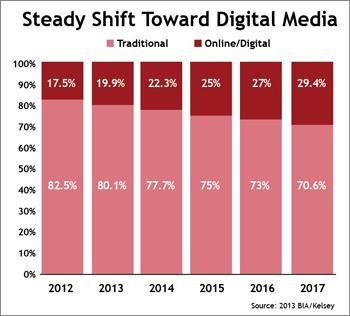
Digital ad spending in local media is expected to grow at a compound annual rate of 14% in the next five years, to $23.1 billion in 2013 and $44.5 billion in 2017. More
rapid digital growth is predicted to drive a 2.8% increase in total local media ad sales to $151.5 billion by 2017.
BIA/Kelsey defines local advertising as some form of targeted
messaging to specific geographic markets spent by national and regional companies, as well as small and medium-sized businesses. It gathers proprietary and secondary information by segment, using
third-party and public company reports to adjust forecasts during the year.
Its latest study highlights the gradual transition from traditional to digital ad spending in the coming
years, although the latter will still make up the vast majority of local ad spending in 2017. Digital spending -- including on mobile devices -- is expected to increase to almost 20% of local ad
spending this year, before going up to almost 30% in 2017.
Mobile local ad spending is projected to grow especially fast, partly because it’s starting from a smaller base. That
total will more than double from $1.4 billion to $2.9 billion in 2013 -- and will reach $4.4 billion in 2014 before hitting $10.8 billion in 2017, or a quarter of overall local digital ad revenue.
Local mobile advertising will account for 37% of total U.S. mobile ad spending this year, before increasing to 52% in 2017, according to the study.
After a 6% gain in
2013, BIA/Kelsey projects that local digital ad sales will jump almost 16% to $30.7 billion next year as a result of various factors, including a slightly improving U.S. economy, a more positive
investor outlook, and the 2014 elections and Winter Olympics. The rollout of the Affordable Healthcare Act is also expected to generate higher local ad spending.
To highlight the
inroads that digital will make in the local ad business, the report compared the proportion of dollars that online and traditional media will represent in 2017. Newspaper print, for example, will fall
to 9.1% of spending, while online newspapers remain steady at 2.4%. Yellow Pages print will decline to 1.5%, while increasing to 1.9% on the digital side.
The gap between traditional
radio and TV and their digital counterparts will remain wide, however. Terrestrial radio will see its share of spending fall slightly to 10.6% by 2017, while digital radio will claims just 0.5%.
Spending on local over-the-air TV will also decline a bit to 14.6%, while dollars going to local TV Web sites will amount to 0.7%
advertisement
advertisement
.